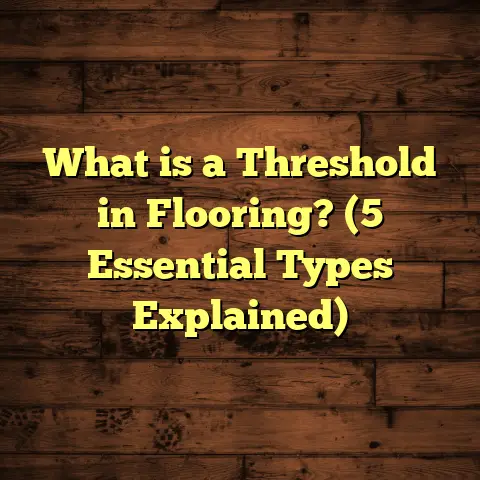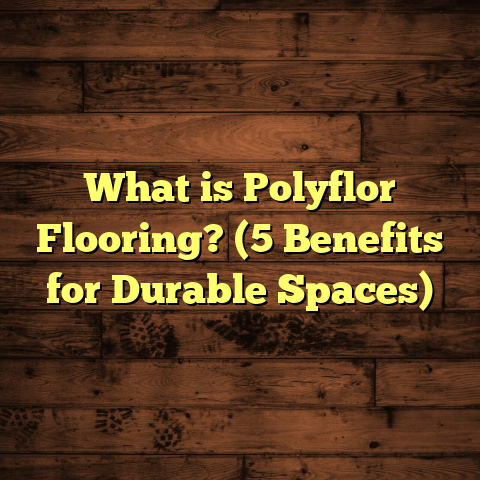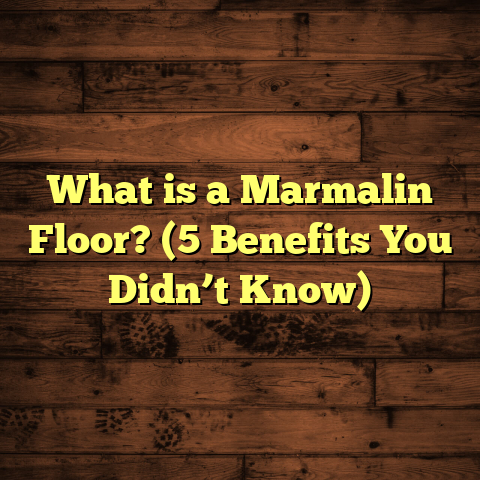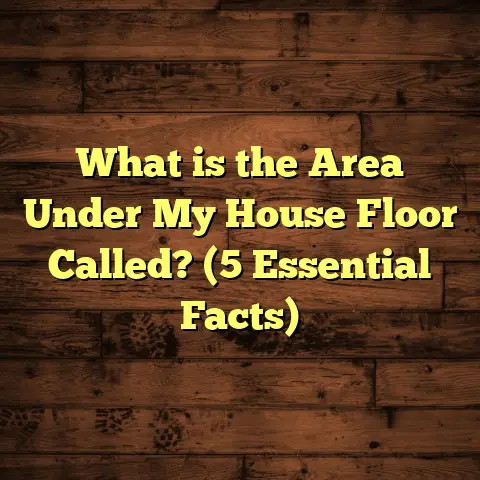What is the Wear Layer on Mohawk Woodlands Vinyl Flooring? (5 Key Benefits Explained)
Introduction
I want to share a story that might sound familiar if you’ve ever had flooring troubles at home. A few years back, I was working with a young couple in Raleigh, North Carolina, who had recently installed vinyl flooring in their living room. Within just a couple of years, they started noticing scratches and dull spots appearing in places where their kids played and where the dog often lounged. They were frustrated because the floor looked brand new when installed, but now it seemed worn out prematurely.
They asked me, “Is this normal? Did we get the wrong flooring?” I asked them what brand and style they picked—the answer was Mohawk Woodlands Vinyl Flooring—but they had not paid attention to the “wear layer” thickness at all when buying it.
That moment really emphasized how many homeowners don’t realize how critical the wear layer is to vinyl flooring performance and longevity.
Over the years, I’ve helped many clients avoid this kind of disappointment by educating them about the role of the wear layer—especially on Mohawk Woodlands products—as well as how to choose one suited to their lifestyle and budget.
If you’re considering Mohawk Woodlands Vinyl Flooring or just curious about what makes some vinyl floors hold up better than others, understanding the wear layer is key.
Let me walk you through exactly what a wear layer is, why it matters so much, and what benefits you can expect from Mohawk’s technology.
What is the Wear Layer on Mohawk Woodlands Vinyl Flooring?
When I first started explaining this to clients, I noticed that many thought of vinyl flooring as one solid material, but it’s actually multiple layers pressed together—each serving an important job.
The wear layer is the very top coating that protects everything underneath—from the printed design film that gives the floor its look to the core layers that provide stability.
Mohawk’s Woodlands line typically features a clear protective coating made from urethane or aluminum oxide compounds.
This coating can vary in thickness measured in mils; one mil equals 0.001 inches thick. Residential vinyl floors often have wear layers between 12 mils (about 0.012 inches) and 20 mils (0.020 inches), depending on the exact product choice.
Thicker wear layers tend to offer better protection but come at a higher price point.
Here’s a bit more detail about what goes into the wear layer:
- Urethane-based coatings: These provide flexibility and resistance against scratches and stains.
- Aluminum oxide particles: Often added for extra hardness; these help resist abrasion from shoes or furniture.
- UV inhibitors: Included to prevent fading when floors are exposed to sunlight.
The manufacturing process involves applying this protective coat as a thin film over the printed vinyl design before everything gets fused under heat and pressure.
The result is a transparent shield that’s tough enough to take daily abuse but also clear enough so your floor’s woodgrain or stone pattern shines through vividly.
In my installations across different climates—from humid Florida homes to dry Colorado cabins—I’ve noticed Mohawk’s wear layers hold up well without peeling or yellowing like cheaper vinyl brands sometimes do.
Five Key Benefits of the Wear Layer on Mohawk Woodlands Vinyl Flooring
1. Enhanced Durability Against Scratches and Dents
One thing I always stress is that no flooring is completely scratch-proof—but a thick, well-made wear layer minimizes visible damage tremendously.
I once worked with a family in Austin who had two large dogs constantly running around their home’s kitchen area. They chose Mohawk Woodlands with a 20-mil wear layer after I explained it would stand up better to pet claws compared to thinner options.
Even after a year filled with playtime chaos, their floor showed minimal scratches or marks.
Lab testing backs this up: abrasion resistance tests like ASTM D4060 simulate thousands of foot traffic cycles using abrasive wheels on samples.
Floors with a 15 to 20 mil urethane/aluminum oxide wear layer consistently outperform thinner ones by resisting surface scratches up to 10,000 cycles without noticeable damage.
In contrast, floors with thinner layers around 8–10 mil start showing scuffs after fewer than 2,000 cycles.
Compared with hardwood floors—which can dent or scratch deeply—vinyl with a thick wear layer offers excellent durability for active households or commercial spaces like offices or daycare centers.
If you have kids or pets—or just like heavy furniture—opting for a thicker wear layer reduces worry about replacing floors too soon.
2. Resistance to Stains and Spills
Another big concern I hear from homeowners is about stains—especially those caused by wine spills, cooking oils, ink marks from kids, or pet accidents.
The wear layer acts as a barrier preventing liquids from penetrating deeper into flooring layers where stains can become permanent.
Mohawk’s Woodlands vinyl uses stain-resistant coatings that chemically repel common household liquids.
In one case study I remember from a Chicago family’s kitchen floor, grape juice spilled repeatedly over several days was easily wiped away without leaving marks because of this protective surface.
The chemistry behind this involves cross-linked urethane polymers that create a nonporous surface where liquids bead up rather than soak in.
This means you don’t have to worry about discoloration or odors developing underneath your floorboards after accidents.
Cleaning routines become simpler too—you can use mild detergents or vinyl floor cleaners without risking damage to the protective finish.
I always recommend quick cleanups after spills and avoiding harsh chemicals like bleach or ammonia that might degrade the wear layer over time.
Additionally, many manufacturers—including Mohawk—will void warranties if you use improper cleaning methods that harm the wear layer, so knowing how it works can save money down the line.
3. Increased Longevity of Flooring
How long can you realistically expect your Mohawk Woodlands vinyl floor to last?
This often depends mostly on how thick and strong your floor’s wear layer is combined with how well you maintain it.
Based on my experience installing floors in diverse households—and supported by data from flooring associations—the average lifespan for residential vinyl with:
- A 12–15 mil wear layer is roughly 10–15 years.
- A 15–20 mil wear layer can last 15–20 years or more under normal conditions.
There are exceptions depending on environment—for example:
- Humid areas like coastal Florida might see slightly reduced lifespan due to moisture exposure.
- UV exposure near large windows can cause color fading if UV inhibitors aren’t present.
Still, flooring with thicker wear layers generally outperforms cheaper vinyl options that may last only 5–7 years before showing serious damage or needing replacement.
I recall a project in Denver where a commercial client upgraded from standard vinyl (10 mil) to Mohawk Woodlands with a 20-mil wear layer specifically because they wanted durability for heavy foot traffic over a decade without costly repairs.
When balancing initial costs against longevity, investing in a thicker wear layer saves thousands over time by delaying replacement cycles.
4. Better Appearance Retention
Vinyl flooring isn’t just about protecting your subfloor—it’s also about maintaining an attractive look for years.
Mohawk includes UV inhibitors in their Woodlands line’s wear layers that reduce sunlight-driven fading by about 30% compared to untreated vinyl floors.
I’ve installed floors next to large south-facing windows where sunlight hits directly for hours daily; these floors retain color vibrancy far longer than older vinyls I’ve seen turn dull yellow or fade unevenly within a year or two.
The gloss level and texture embossed into Woodlands flooring also stay consistent thanks to durable top coatings—not worn away by repeated footfalls or cleaning routines.
This means your floors keep their “just installed” look longer without needing polishing or refinishing like hardwood sometimes requires.
Clients often tell me they appreciate how their floors’ natural wood grain patterns stay sharp and appealing despite heavy use across living rooms or kitchens.
5. Easier Maintenance and Cleaning
A thick protective wear layer makes routine maintenance straightforward—which is why many homeowners appreciate Mohawk Woodlands vinyl after installation.
I always advise clients they can clean using:
- Soft brooms or vacuum attachments designed for hard floors.
- Damp mops with mild cleaning solutions recommended by manufacturers.
Because the surface resists scratches and stains well, you avoid aggressive scrubbing or chemical treatments that could damage other floor types.
One client shared how she saved hours every month because her floor didn’t need special polishes or waxing—just gentle mopping kept it looking great year-round.
To protect your investment further:
- Use felt pads under furniture legs.
- Place doormats at entrances.
- Avoid dragging heavy objects across floors directly.
These simple habits combined with a strong wear layer keep your floors functional and beautiful longer without costly upkeep.
The Science Behind Wear Layer Technology
I find understanding how these layers work helps me explain their value more clearly to clients curious about technical details.
Mohawk’s wear layers rely primarily on two materials:
- Urethane Coatings: These polymers cure into tough films providing elasticity plus scratch/stain resistance.
- Aluminum Oxide Particles: Tiny mineral crystals embedded inside add hardness similar to what you find in some hardwood finishes but adapted for flexible vinyl sheets.
This combination means your floor resists abrasions yet doesn’t crack under pressure—a balance essential for comfort as well as durability.
Advances made by Mohawk include improved bonding techniques ensuring these layers don’t peel or delaminate over time—a problem seen occasionally with less reputable brands years ago.
From an environmental standpoint:
Mohawk has reduced volatile organic compound (VOC) emissions during manufacture while increasing recyclability of waste materials—a priority for eco-conscious buyers I work with regularly.
Comparing Wear Layers Across Different Flooring Brands
In my work, clients often ask how Mohawk stacks up against other popular brands like Armstrong or Shaw when it comes to wear layers.
Here’s a quick comparison based on thickness ranges and durability:
| Brand | Typical Wear Layer Thickness | Residential Durability | Common Pricing* |
|---|---|---|---|
| Mohawk | 12 – 20 mil | 10 – 20 years | $2 – $6 per sq ft |
| Armstrong | 8 – 15 mil | 7 – 15 years | $1.50 – $5 per sq ft |
| Shaw | 12 – 18 mil | 10 -18 years | $2 – $6 per sq ft |
| Karndean | 20 – 30 mil | 15+ years commercial | $5 – $12 per sq ft |
*Prices vary by location and retailer; labor costs extra
Mohawk strikes a good balance between price and durability for residential projects—especially if you choose Woodlands lines with thicker wear layers for busy homes.
Installation Insights: How Wear Layer Affects Installation and Handling
You might wonder if thicker wear layers make floors harder to install? In my experience:
The difference between a 12-mil and 20-mil wear layer doesn’t significantly change installation methods but does require careful handling during transport to avoid surface scratches before installation.
I always recommend contractors use protective coverings when carrying planks through job sites—especially since any damage visible after installation can void warranties related to surface finish defects.
Installation times generally range:
- Small rooms (~200 sq ft): 1 day
- Larger rooms (~400 sq ft): up to 3 days including prep
For commercial projects needing thicker commercial-grade flooring (with heavier wear layers), additional subfloor prep may be necessary for flatness ensuring proper adhesion.
Budgeting Flooring Projects with Wear Layers in Mind
Budgeting accurately can be tricky without good tools—which is why I use FloorTally regularly now.
It lets me input variables like:
- Local labor rates ($1-$3 per sq ft depending on region)
- Material costs (e.g., $3-$6 per sq ft for Mohawk Woodlands)
- Waste factor (usually ~5%)
This way I get an instant estimate factoring in how much thicker wear layers add cost upfront but potentially save money long-term by reducing replacement frequency.
For example:
A typical 300 sq ft room install with a 15-mil woodlands vinyl might cost:
| Cost Component | Amount ($) |
|---|---|
| Materials | $900 |
| Labor | $600 |
| Waste & Supplies | $75 |
| Total Estimate | $1,575 |
Switching to a 20-mil wear layer could increase material cost by $300-$600 but extend floor life significantly beyond cheaper options costing less initially but failing faster.
FloorTally helps me communicate these tradeoffs clearly to clients so they make smarter decisions based on their home traffic patterns and budget flexibility.
Maintenance Best Practices for Mohawk Woodlands Vinyl Flooring
Keeping your investment looking great requires some basic care:
- Mop regularly with damp microfiber mops; avoid soaking floors.
- Use pH-neutral cleaners designed for vinyl.
- Place mats at entrances to trap dirt/grit.
- Use furniture pads under chairs/tables.
- Avoid rubber-backed mats which may discolor floors.
Seasonally check for humidity levels—vinyl expands/contracts slightly; maintaining indoor humidity between 40%-60% helps avoid gaps or buckling issues near baseboards.
If you notice scuff marks, try soft erasers or specialized vinyl floor cleaners rather than abrasive scrubbing tools that might damage the wear layer surface.
FAQs From Clients About Wear Layers
Q: Can I refinish vinyl flooring if the wear layer gets damaged?
A: No, unlike hardwood floors you can’t sand or refinish vinyl; if the wear layer wears through, replacement is usually necessary.
Q: Will pet claws ruin my floor even with a thick wear layer?
A: Thick urethane/aluminum oxide layers resist scratches well but very sharp claws may still cause minor surface scuffs; regular nail trimming helps minimize damage.
Q: How do I know what thickness I need?
A: Consider foot traffic volume — low traffic bedrooms can use thinner layers; kitchens/living rooms benefit from thicker ones around 15–20 mils; commercial spaces even thicker if needed.
Final Thoughts
Choosing Mohawk Woodlands Vinyl Flooring with an appropriate wear layer thickness isn’t just about picking pretty woodgrain patterns—it’s about making sure your investment stands up against daily life demands while staying easy to maintain and attractive for years ahead.
From my personal experience installing hundreds of projects across different states—plus supporting data from lab tests and case studies—I always recommend focusing on at least a 15 mil urethane-based wear layer for most residential applications unless foot traffic is very light.
Have you taken time yet to think about your household activity levels? That’s where choosing your ideal wear layer starts because it directly impacts durability, cleaning ease, cost-effectiveness over time—and ultimately your satisfaction long after installation day ends.
If you want help crunching numbers or figuring out what fits your budget best, I usually plug everything into FloorTally—it saves time calculating real local costs instead of guessing—and provides clear info so no surprises pop up later in your project timeline.
Feel free to reach out anytime if you want me to walk you through specific product choices or share tips tailored exactly for your home setup!





